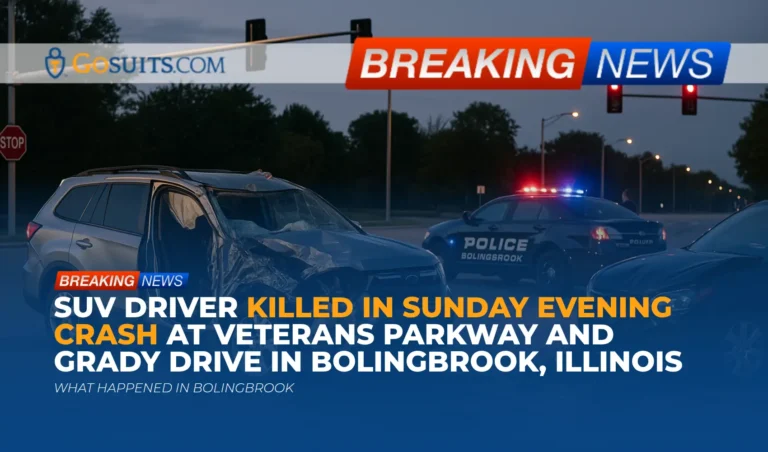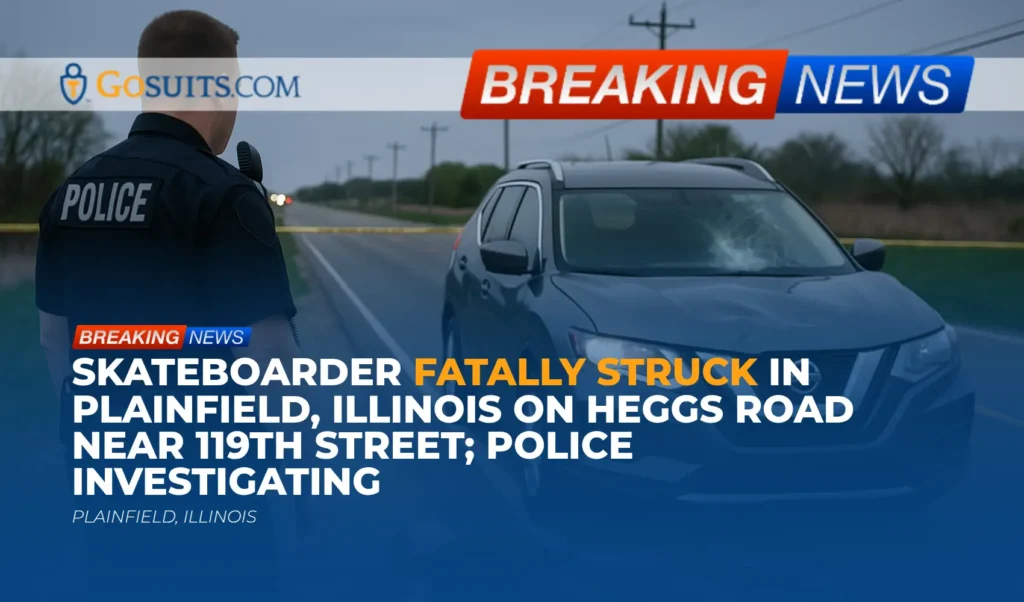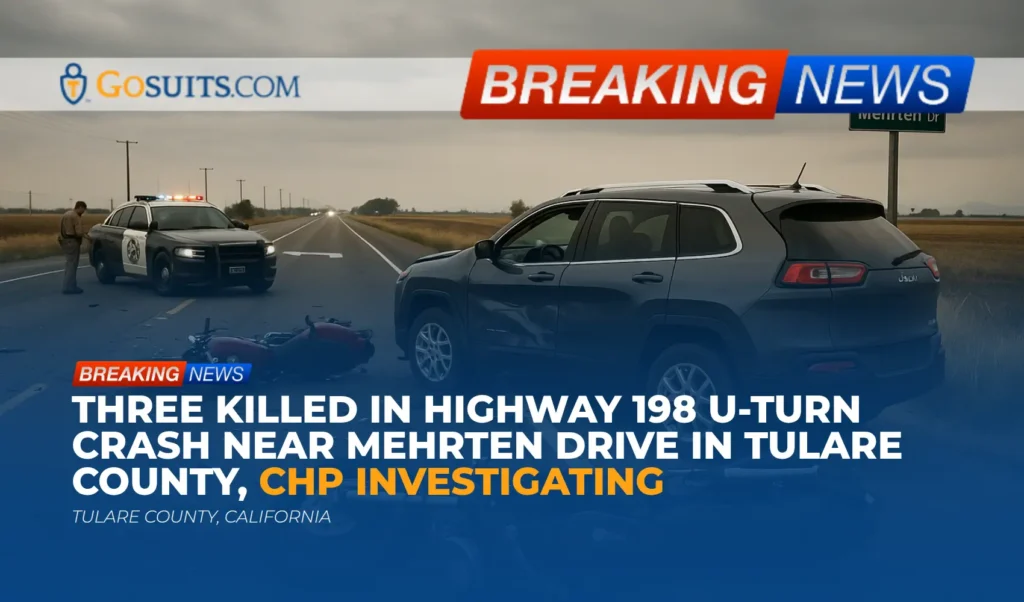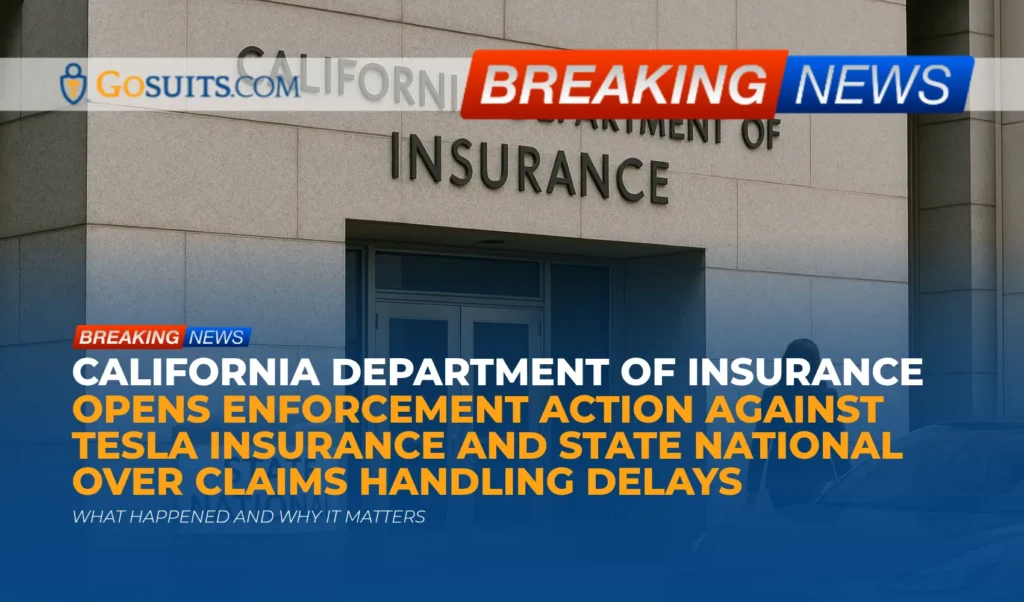- What Happened in Bolingbrook
- Time and Place of the Collision
- Intersection Crashes and Right of Way Under Illinois Law
- Key Civil Liability Questions Investigators Often Examine
- How to Obtain Official Records and Where to Call
- Preserving Evidence and Protecting a Family’s Options
- Insurance and Potential Civil Claims After a Fatal Crash
- Community Safety Notes for Veterans Parkway and Grady Drive
- How Police and Coroners Determine Cause in a Fatal Crash
- Staying Informed About Official Updates
- Commentary from Gosuits Bolingbrook, Illinois Personal Injury Attorney
- If Action Is Needed, Here Is A Responsible Way To Proceed
What Happened in Bolingbrook
According to local reporting, a fatal two-vehicle collision occurred in Bolingbrook, Illinois, on Sunday evening. Police indicated that just before 7 p.m., officers responded to the intersection of Veterans Parkway and Grady Drive. Preliminary information shared by law enforcement stated that an SUV heading north on Grady attempted to cross Veterans Parkway and was struck by a westbound sedan traveling on Veterans Parkway. The SUV’s driver was pronounced deceased at the scene. The driver of the sedan was taken to a hospital for evaluation. Authorities withheld the identity of the deceased pending notification of next of kin. At the time of the initial report, no additional details were released.
For families reading this, please know that many people in the community are thinking of you. Early information is often limited while investigators gather facts. The lack of detail in the first hours does not reflect the importance of the case. It is a normal part of how serious crashes are investigated.
Time and Place of the Collision
The crash was reported just before 7 p.m. at the intersection of Veterans Parkway and Grady Drive in Bolingbrook. This is a well-traveled area, and conditions such as traffic control devices, sight distance, evening light conditions, and vehicle speeds can all be relevant to understanding how an intersection collision unfolded. Early in an inquiry, investigators will typically note weather, lighting, and roadway design features, then collect electronic data and witness statements.
Intersection Crashes and Right of Way Under Illinois Law
Illinois law sets duties for drivers approaching intersections, including yielding at stop or yield signs and maintaining a careful lookout. While no one should assume the precise traffic control pattern at this location without official confirmation, these general rules often apply in similar settings:
- Stop or yield control: When an intersection is controlled by stop or yield signs, drivers must comply and yield to cross traffic that constitutes an immediate hazard. See 625 ILCS 5/11-904 (Illinois statute on stop and yield intersections).
- Entering an intersection: Drivers entering an intersection must proceed only when it is safe, taking into account oncoming or cross traffic that has the right of way. See 625 ILCS 5/11-901 (approaching or entering intersections).
- Turning and yielding: When making turns, drivers must yield to vehicles approaching from the opposite direction when they present a hazard. See 625 ILCS 5/11-902 (left turns and yielding).
National safety data show that intersections are complex driving environments, and a significant share of crashes are intersection related. The National Highway Traffic Safety Administration provides an overview of intersection safety concerns and common contributing factors like recognition errors and inadequate gap acceptance (NHTSA on intersections). The Federal Highway Administration also outlines how design and traffic control influence risk (FHWA intersection safety).
Key Civil Liability Questions Investigators Often Examine
In the civil context, liability after a collision depends on facts proven through objective evidence. The following questions commonly guide a careful analysis. They are not conclusions about this incident, but they illustrate the types of issues that matter:
- Right of way and traffic control: Which approach had the right of way and what control devices were present. Did any driver fail to stop or yield as required.
- Speed and approach: Were either or both vehicles traveling at a speed unsafe for conditions. Event data recorders and reconstruction methods can shed light on pre-impact speed and braking.
- Visibility and line of sight: Was the view obstructed by parked vehicles, landscaping, signage, or lighting conditions.
- Driver attention: Was distraction, impairment, or fatigue a factor. Objective indicators may include phone records, toxicology results, and witness observations.
- Roadway design and maintenance: Were pavement markings, signs, or signals adequate and functioning. Were there engineering elements that increased risk.
- Comparative negligence: Illinois follows a modified comparative fault system. A claimant who is more than 50 percent at fault is barred from recovery, and damages can be reduced by a claimant’s percentage of fault. See 735 ILCS 5/2-1116 (comparative fault).
These issues are typically resolved by combining police reports, scene photographs, physical evidence, black box data, witness statements, and sometimes expert reconstruction. Families should avoid speculation and wait for documented findings, while also taking steps to preserve their own evidence.
How to Obtain Official Records and Where to Call
After a fatal crash, families often need certain documents for insurance, probate, or potential civil claims. The list below explains what to request and where to start. Availability depends on the stage of the investigation and on which agencies have jurisdiction.
Police crash report and supplements
For crashes within Bolingbrook, the municipal police department typically generates the primary report and any supplemental narratives. Ask the department’s Records Division how and when reports may be released. If the Illinois State Police were involved, crash reports may be available through the State Police crash report portal (Illinois State Police Crash Reports).
Illinois uses a standardized traffic crash report. Some materials, such as active investigative notes or certain videos, may be withheld until the investigation is complete. If needed, a formal request under the Illinois Freedom of Information Act can be made. See 5 ILCS 140 (Illinois FOIA statute).
911 recordings, body-worn camera, and dash camera video
Where available and when not exempt, families or their representatives can request 911 audio, dispatch logs, and camera footage through a records request process. Policies differ by agency, and some items are only released to next of kin or their authorized representatives. FOIA provides the general framework, but specific exemptions for ongoing investigations apply. See 5 ILCS 140 (Illinois FOIA statute).
Coroner or medical examiner records
Because Bolingbrook spans both Will County and DuPage County, jurisdiction for a death investigation can depend on the exact location and circumstances. If the incident falls within DuPage County’s jurisdiction, the DuPage County Coroner provides guidance on requesting reports and autopsy findings (DuPage County Coroner). If Will County has jurisdiction, contact the county coroner’s office to ask about next-of-kin procedures, autopsy status, and how to request public records when available.
Families should be aware that release of autopsy and toxicology results can take weeks. This timing is normal. Official results help clarify cause and manner of death, which can be relevant in civil claims and for settlement discussions with insurers.
Death certificates
Certified death certificates are usually needed for estate matters, insurance, and benefits. The Illinois Department of Public Health explains how to obtain death records and who is eligible to request them (IDPH Vital Records). Funeral homes often assist with initial requests.
Traffic engineering information
In some cases, families or their representatives request information about traffic controls, signal timing, or prior crash history. The Illinois Department of Transportation provides traffic safety resources and data tools that can help contextualize a location’s risk profile (IDOT Traffic Safety). Formal requests for specific intersection data may be routed to the local municipality or county transportation department, depending on ownership of the roadway.

Who to call first
- Local Police Records Division: Ask about the availability and process to obtain the traffic crash report and any supplements.
- County Coroner’s Office: Confirm jurisdiction, ask about autopsy status, and request information about obtaining the coroner’s report when available.
- Illinois State Police: If they investigated or assisted, use the State Police crash report portal linked above.
- Illinois Department of Public Health: For certified death certificates through the Vital Records program.
When making calls, have the incident date, approximate time, intersection name, and the investigating officer’s name or badge number if known. If reaching out as next of kin, note your relationship to the decedent.
Preserving Evidence and Protecting a Family’s Options
Two things often make a difference in the months following a serious crash: securing records early and avoiding unintentional statements to insurers.
- Preserve vehicle and property evidence: Request in writing that the involved vehicles not be destroyed until both law enforcement and your chosen representatives have had a chance to document them. Event data recorders can hold valuable information about speed and braking.
- Collect scene information: Photographs of the intersection, skid marks, debris fields, and sight lines can be important. If it is safe and lawful, collect images as soon as practical or ask a representative to do so.
- Identify witnesses: Write down names, phone numbers, and email addresses of people who stopped to help or who live or work near the intersection.
- Store medical and funeral records: Keep copies of all bills and records related to emergency response, hospital care, and funeral arrangements. These documents help demonstrate losses that may be recoverable in a civil claim.
- Be cautious with insurers: Before speaking with any insurance company, consider consulting an attorney. Statements to insurers can be recorded and may be used later in ways that limit a civil claim. A free consultation can clarify rights and next steps.
If a governmental entity may be implicated, additional rules and shorter timelines can apply to claims. Preserving evidence promptly can be critical in those situations.
Insurance and Potential Civil Claims After a Fatal Crash
Illinois law recognizes several potential civil pathways after a fatal motor vehicle collision. The most appropriate approach depends on evidence regarding fault, the parties involved, and the insurance coverages in place.
Wrongful death and survival claims
- Wrongful Death Act: Illinois allows designated beneficiaries to seek damages for losses resulting from a wrongful death. See 740 ILCS 180/2 (Wrongful Death Act, section 2).
- Survival claims: Separate from wrongful death, a survival action allows recovery for the decedent’s claims that existed before death, such as conscious pain and suffering. See 755 ILCS 5/27-6 (Illinois Survival Act).
Case strategy often involves both wrongful death and survival claims, pursued by the estate’s representative on behalf of next of kin. The appropriate personal representative is generally appointed through probate.
Statutes of limitation to be mindful of
- General personal injury: Two years is the limitation period for actions for damages for an injury to the person. See 735 ILCS 5/13-202 (personal injury limitations).
- Wrongful death: Generally two years from the date of death. See 740 ILCS 180/2 (Wrongful Death Act limitations).
- Claims involving local public entities: When a local public entity or its employee is a defendant, a one year limitations period can apply. See 745 ILCS 10/8-101 (Local Governmental and Governmental Employees Tort Immunity Act).
These are general statutory frameworks. Unique facts can change deadlines or notice requirements. That is one reason families often seek a timely case review.
Liability insurance and uninsured coverage
- Mandatory liability coverage: Illinois law requires drivers to carry liability insurance. See 625 ILCS 5/7-601 (mandatory insurance statute).
- Uninsured motorist coverage: Illinois requires uninsured motorist coverage on auto policies. See 215 ILCS 5/143a (Illinois Insurance Code). Underinsured motorist coverage is common but depends on the policy.
- MedPay: Medical payments coverage is optional. It can help with immediate expenses regardless of fault, subject to policy terms.
Insurance companies may reach out quickly to ask for statements or to discuss property damage or potential settlement. Before speaking with any insurer, consider consulting a lawyer to understand rights and obligations. What is said in recorded calls can affect fault determinations and claim valuation.
Community Safety Notes for Veterans Parkway and Grady Drive
While investigators determine exactly what happened here, communities can use well-established safety practices to lower risk at busy intersections. National sources emphasize engineering, enforcement, and education. The Federal Highway Administration outlines strategies such as visibility improvements, signal timing optimization, and access management to reduce conflicts (FHWA intersection safety). NHTSA highlights common driver errors at intersections and offers guidance for safer approaches, including careful scanning and yielding correctly to cross traffic (NHTSA on intersections).
Local observations from residents and businesses often identify practical improvements. Examples include trimming vegetation that blocks views, upgrading or refreshing pavement markings, improving nighttime lighting, reviewing posted speed limits, and studying whether turn lanes or protected signal phases would help. Where a history of severe crashes exists, agencies may consider an engineering study or targeted enforcement to address specific risk patterns.
How Police and Coroners Determine Cause in a Fatal Crash
Major crash investigations usually proceed in phases. Understanding the process can help families anticipate timelines:
- Scene response: Police secure the intersection, render aid, and document the location of vehicles, debris, skid marks, and roadway conditions. Photographs and measurements are taken.
- Data collection: Officers or crash reconstructionists may download event data from vehicles, obtain surveillance video from nearby cameras, and identify independent witnesses.
- Medical findings: The coroner or medical examiner determines cause and manner of death, and toxicology testing is performed as indicated.
- Report compilation: Investigators draft a narrative, diagrams, and in some cases a reconstruction analysis. For fatalities, the data typically feeds into state and national reporting systems such as the Fatality Analysis Reporting System maintained by NHTSA (NHTSA FARS).
- Agency review: Supervisors may review findings, and reports are then released according to policy and applicable law.
It is common for final documentation to take several weeks, especially when waiting on laboratory results. Families can check in periodically with the investigating agency’s liaison or records unit for status updates.

Staying Informed About Official Updates
The investigating police department is the authoritative source for updates on this crash. Public information officers often release new details when they do not jeopardize the investigation or next of kin notifications. Local governments may post incident updates through official webpages or public safety channels. If in doubt, contact the police department’s non-emergency number and ask to be directed to records or the public information office for guidance on when a report might be available.
For broader safety context, the Illinois Department of Transportation shares statewide data dashboards and safety resources that can help communities understand trends and advocate for improvements where needed (IDOT Traffic Safety).
Commentary from Gosuits Bolingbrook, Illinois Personal Injury Attorney
We are deeply sorry to learn that a member of our community has lost their life in this collision, and we extend our heartfelt condolences to the family and everyone affected. This article is offered for educational and general informational purposes, with respect for those suffering this loss.
Based on the initial description, this appears to be a classic intersection crash involving a vehicle crossing a through roadway and another vehicle traveling along that through route. In the civil context, outcomes often turn on right of way rules, speed, visibility, and whether any driver failed to yield at a controlled approach. Physical evidence from the scene, vehicle event data, and coroner findings typically provide clarity. Because early accounts are preliminary, it is prudent to allow the fact gathering to conclude before drawing firm conclusions.
In our experience, insurance carriers and corporate defendants often move quickly to shape the narrative. Adjusters may request recorded statements, ask leading questions, or reference policy language in ways that are confusing during a time of grief. When families are still trying to understand what happened, it is easy to say something that an insurer later uses to dispute fault or reduce compensation. Having a skilled advocate engage with insurers can help ensure that the evidence is gathered thoroughly and that rights are protected under Illinois law.
Free consultations are important because they give people a chance to understand their options without pressure or cost. A prompt conversation can help identify urgent steps, like preserving vehicle data, requesting records, and avoiding missteps with insurers. Even if a family decides not to pursue a claim, understanding the legal landscape can provide peace of mind and prevent avoidable harm.
If Action Is Needed, Here Is A Responsible Way To Proceed
- Start by documenting: Write down everything known about the date, time, and location, and gather any photographs, witness contacts, and medical or funeral documents. This creates a foundation for future steps.
- Request official records methodically: Ask the police records unit when the crash report will be available, and inquire with the county coroner about the process and timing for autopsy findings. Confirm how to request 911 audio or camera footage if appropriate.
- Preserve vehicles and data: If any involved vehicle is within your control or a towing facility’s control, request in writing that it be preserved until it can be inspected. Event data can be lost if a vehicle is salvaged.
- Consult before calling insurers: Speak with an attorney for a free consultation before giving any recorded statement. What is said to an insurer can be used later and may affect fault and coverage issues.
- Be mindful of timelines: Illinois has strict filing deadlines for wrongful death and related claims, and shorter deadlines may apply when a local public entity is involved. Acting sooner helps ensure that options remain open and that evidence is not lost.
- Care for well-being: Consider leaning on community and professional support. Grief resources from public health agencies can be helpful during this period (CDC grief resources).
Taking these steps early can clarify the path ahead, help protect rights, and reduce the risk of avoidable setbacks while official investigations proceed.






